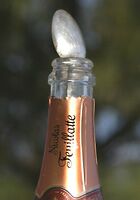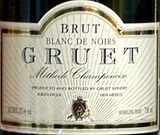|
In this week's Premium Edition: Exceptional Champagne
A lot of corks will pop on New Year's Eve, and many of the celebratory bottles will come from the major, well-known producers of Champagne and other top sparkling wines. But in the interest of finding both quality and value on the road less traveled, I'm recommending an excellent bubbly from a more artisanal producer. You'll find my recommendation, and more details, in tomorrow's Wine Advisor Premium Edition, our subscription-only E-letter that helps you shop with confidence when you're considering a more pricey bottle for a special occasion. The $24 subscription price - no more than you'd pay for a bottle of exceptionally fine wine - will bring you a full year of 26 biweekly E-mail editions. Proceeds go to buy these special wines at retail, and help support WineLoversPage.com too! Click here to subscribe today, and this week's edition will arrive in your E-mail box tomorrow.
Want to take a look at a free sample first? Click here:  Silver spoon
Silver spoon
In another of those enduring myths about wine, I frequently get E-mail - especially around this time of year when New Year's Eve celebrations have us thinking about bubbly - either asking me or telling me about the old trick of keeping leftover Champagne alive with a silver spoon. Whut? You heard me the first time: Around the wine world, there's a strong, persistent tradition that proclaims the best way to keep Champagne fresh and sparkly in an opened bottle is to hang a silver spoon in its neck. I've never heard a reasonable scientific explanation for this alleged phenomenon, but it's widespread enough to earn a place on my list of frequently asked wine questions. But does it work? There was only one way to find out, and this year, while tasting a few bubblies for seasonal articles, it occurred to me to put the theory to a simple test. Faced with two partly finished bottles of decent bubblies - the New Mexico Gruet featured today and a fine artisanal rosé Champagne to be featured in tomorrow's Premium Edition - I set up a simple test. After dinner, I put one bottle in the refrigerator with no effort to protect it, just a bottle standing open on the top shelf next to the milk and a tub of kalamata olives of dubious age. The other wine got the silver-spoon treatment. We had to dig around to find a somewhat tarnished baby spoon - the handle on a regular model was a little too wide to fit. It went into the fridge with the bowl sticking out the top and the handle dangling inside, where it ended well short of touching the surface of the wine. Twenty-four hours later, we tried the wines again. Had they gone flat? Well, no. As a matter of fact, both wines poured up with a frothy mousse, lasting streams of bubbles, and the creamy, foamy mouthfeel that carbonation imparts. I could detect no real difference between their character on the second night and the impressions I had recorded upon opening the wines the night before. We spent a little time closely examining each wine and trying to detect whether one was more "bubbly," but the answer - within the less-than-rigorous framework of this casual test - was that both wines remained in fine shape. I expected this, frankly. Here's the story: Champagne (and other world sparkling wines made by a similar process) will keep surprisingly well for a day or two under refrigeration with no protection at all, not even recorking or a special stopper. Why? Simple enough. The bubbles in sparkling wine are carbon dioxide (CO2), a gas that's both inert and heavy. Within minutes after you pop the cork, CO2 forms a protective blanket on top of the wine, more than adequate to forestall oxidation and hold much of the remaining carbonation in liquid form, especially under refrigeration. Adding the silver spoon does no harm, but it does no particular good, either. You simply don't need it. I wouldn't recommend this treatment for more than a few days. Even under refrigeration, even recapped, an open bottle of bubbly will eventually go flat. But if you find yourself with a little left over after your New Year's toasting, and feel that it's too good to waste, you know what to do!
TALK ABOUT WINE ONLINE If you prefer to comment privately, feel free to send me E-mail at wine@wineloverspage.com. I'll respond personally to the extent that time and volume permit.  Gruet Blanc de Noirs Brut ($13.99)
Gruet Blanc de Noirs Brut ($13.99)
This clear, pale-gold sparkling wine from New Mexico shows bright-gold glints against the light but no hint of pink despite its being a blanc de noirs (white sparkling wine made from "black" Pinot Noir grapes). It froths up in a foamy mousse when poured, then falls back to a lasting bubble stream. Apples and a hint of milk chocolate combine in an appealing aroma. Crisp and tart, ripe apples and tangy fresh-fruit acidity define the flavor; carbonation provides a foamy mouthfeel. Not overly long, but tart lemon-squirt acidity remains in a cleansing finish. A particularly good sparkler to go with food. (Dec. 20, 2004) FOOD MATCH: As noted, this is a food-friendly sparkler. It made a stunning match with a roast chicken with thin slices of Oregon black truffle poked beneath the breast skin. VALUE: At one-half to one-third the price of non-vintage Champagne, its quality rises significantly above its price point. Shop around, though, as pricing varies - I've paid as high as $19 for this wine at some retailers. WHEN TO DRINK: Non-vintage sparkling wines aren't for aging, and will eventually lose both their fruit and their fizz in the cellar. In my experience, though, Gruet's bubblies can be held for a year or two with no perceptible degradation.
WEB LINK:
FIND THIS WINE ONLINE:  Spanish Sensation from The California Wine Club! The upcoming International Selections from The California Wine Club features two flamboyant and flavorful wines from Spain! The 1998 Marques de Caro Reserva is a full-bodied red wine that blends Cabernet Sauvignon with Tempranillo. The 2003 La Fontana Albarino is a classic white wine high in acidity and an ideal complement for seafood tapas! This month's International Selections is $69 and includes all shipping, handling and import charges. The wines for the International Selections are imported directly by The California Wine Club and not currently found anywhere else in the U.S.A. For a worldwide adventure in wine call The California Wine Club today and join their International Selections. Shipments arrive every other month or quarterly and include two bottles of outstanding international wine from countries like Italy, France, Spain and South Africa to name a few! Included with each shipment is an engaging 4-page newsletter highlighting the families behind the wine, tasting notes and fun facts about the wine's country of origin.
Call 1-800-777-4443 or visit Wine Lovers' Voting Booth: Wine buying strategy for 2005 It's almost New Year's Day, a time for looking forward and looking back. For those of us whose interest in the tasty topic makes "wine buying" a separate line in the family budget, this is as good a time as any to think about our wine-buying strategies and consider whether we should keep on keeping on or do things differently in 2005.
This week we invite you - in the anonymous comfort of the Wine Lovers' Voting Booth - to think about your own wine-related plans for the New Year and tell us about your wine buying strategy for 2005. To cast your ballot, click to the Voting Booth, This week on WineLoversPage.com Here are links to some of our recently published articles that I think you'll enjoy:
• Bucko's Wine Reports: Late Autumn Releases
• Wine Lovers' Discusstion Group: What did you drink with Christmas dinner? Last Week's Wine Advisor Index The Wine Advisor's daily edition is usually distributed on Mondays, Wednesdays and Fridays (and, for those who subscribe, the FoodLetter on Thursdays). Here's the index to last week's columns:
• Seven fish, one wine (Dec. 24, 2004)
• A seasonal chuckle (Dec. 22, 2004)
• Winter is icumen in (Dec. 20, 2004)
• Complete 30 Second Wine Advisor archive:
• Wine Advisor FoodLetter: Truffles! (Dec. 23, 2004)
• Wine Advisor Foodletter archive:
SUBSCRIBE: Administrivia To subscribe or unsubscribe from The 30 Second Wine Advisor, change your E-mail address, or for any other administrative matters, please use the individualized hotlink found at the end of your E-mail edition. If this is not practical, contact me by E-mail at wine@wineloverspage.com, including the exact E-mail address that you used when you subscribed, so I can find your record. We do not use our E-mail list for any other purpose and will never give or sell your name or E-mail address to anyone. I welcome feedback, suggestions, and ideas for future columns. To contact me, please send E-mail to wine@wineloverspage.com All the wine-tasting reports posted here are consumer-oriented. In order to maintain objectivity and avoid conflicts of interest, I purchase all the wines I rate at my own expense in retail stores and accept no samples, gifts or other gratuities from the wine industry.
Monday, Dec. 27, 2004 |




